April 11, 2013 – Every tax professional, most small business owners and a good number of other taxpaying Americans know that last-minute changes to the tax code this year resulted in a delayed tax filing season.
For tax professionals, that meant a shortened tax season to file hopefully the same or more returns, while for many taxpayers, it meant a delay in receiving their refunds. But how did it affect the Internal Revenue Service?
Today, the Treasury Inspector General for Tax Administration (TIGTA) released a report detailing how that has impacted the IRS, noting that the agency had received fewer tax returns so far in the 2013 filing season when compared to the same period last year.
It also found that the average tax refund decreased slightly to $2,894 in 2013, compared with $2,944 during the same period last year.
The tax return filing season is a critical period for the IRS since it is during this time that most individuals file their income tax returns and contact the IRS if they have questions about specific tax laws or filing procedures. In this “Interim Results of the 2013 Filing Season” report, TIGTA reviewed the IRS’s performance through early March. A final report that reviews the entire filing season will be issued in September.
“This filing season is a particularly challenging one for the IRS,” said J. Russell George, Treasury Inspector General for Tax Administration. “The IRS had a very tight time frame in which to update tax forms, instructions and publications and reprogram its computer systems before accepting returns.”
Enactment of the American Taxpayer Relief Act of 2012 on January 2nd, 2013, reduced the time the IRS had to implement the tax changes the law contained. The IRS began accepting most tax forms [and schedules] just eight days after the originally planned start of the filing season. However, some individual taxpayers had to wait until March 4th to have their tax returns processed. In addition, the Budget Control Act of 2011 required Federal agencies, including the IRS, to implement mandatory budget cuts if Congress did not enact a Fiscal Year 2013 budget by March 1st. On March 5th, the IRS announced that it would have to make significant cuts in all major programmatic areas, including customer service, for the remainder of the Fiscal Year.
As of March 9th, the IRS had received more than 65 million tax returns down from the nearly 72 million returns filed during the same period in 2012. More than 59 million (91 percent) of the returns were filed electronically, down from 64 million e-filed in 2012. The IRS issued more than 53 million refunds totaling nearly $155 billion as of March 9th, compared to 59.2 million refunds totaling more than $174 billion in 2012. The average refund decreased slightly to $2,894 in 2013, compared with $2,944 during the same period last year.
This is the first year in which the IRS has relied solely on the Modernized e-File (MeF) system to receive and process individual tax returns; and more taxpayers are filing electronically this year – 91 percent. TIGTA found that a significant number of taxpayers are using the option to split tax refunds between multiple bank accounts. Through March 7th, 527, 872 individuals split tax refunds totaling more than $2.3 billion between two or three different checking and savings accounts, compared with 662,983 tax returns with refunds totaling $2.9 billion last year.
TIGTA identified 288,187 tax returns using split refunds that requested direct deposits totaling more than $113 million into 31,934 bank accounts as of March 7. Each of the 31,934 bank accounts TIGTA identified had refunds deposited from three or more taxpayers. Sixty-one percent of the returns were prepared by paid tax preparers.
Other significant findings include:
Taxpayer Assistance Centers: Due to reduced staffing, the IRS planned to assist only six million taxpayers at its walk-in offices in 2013, 11.8 percent fewer than in 2012.
Toll-Free Telephone Assistance: As of March 9th, IRS assistors had answered 8.3 million calls and achieved a 67.8 percent Level of Service, compared to 66.8 percent in 2012.
Internet Self-Help Assistance: In spite of the late start to the filing season, as of March 9th the IRS reported a 21.1 percent increase in the number of visits to IRS.gov website over the same period in 2012. It also reported a 41.7 percent increase in the number of taxpayers obtaining their refund information online via the “Where’s My Refund” option found on IRS.gov.
In addition, the IRS is offering more self-assistance options through various forms of social media including its mobile application IRS2Go, YouTube, Twitter, Tumblr, and Facebook. As of March 21st, 2013, the IRS has had more than 1.9 million new downloads of its IRS2Go mobile application, more than 1.5 million new views of IRS YouTube videos, and a 31 percent increase in Twitter followers.
Fraudulent Refunds: The IRS is continuing to expand its efforts to detect tax refund fraud. As of March 9th, the IRS reported that it identified 220,821 tax returns with $1.86 billion claimed in fraudulent refunds and prevented the issuance of $1.79 billion (96.2 percent) of the fraudulent refunds. This includes 85,385 fraudulent tax returns involving identity theft and 87,817 potentially fraudulent tax returns filed by prisoners for screening.
Earned Income Tax Credit: Many paid tax return preparers continue to be noncompliant with Earned Income Tax Credit (EITC) due diligence requirements. As of March 7th, 2013 TIGTA identified 80,585 paid tax return preparers filing 616,622 tax returns claiming nearly $1.9 billion in EITC without the required Form 8867 attached to the tax return. This equates to more than $306 million in penalties that can be assessed by the IRS.
American Opportunity Tax Credit: The IRS is continuing to issue potentially erroneous Education Credits. As of March 7th, 2013, we identified 18,061 taxpayers who filed tax returns claiming Education Credits totaling $30 million for students who were of an age that are unlikely to be enrolled in a four-year college degree program. In addition, an error in tax preparation software packages caused further delays for individuals claiming the Credit. TIGTA did not make any recommendations in this report.
—
Thanks for reading CPA Practice Advisor!
Subscribe Already registered? Log In
Need more information? Read the FAQs
Tags: Firm Management, Income Tax, IRS




